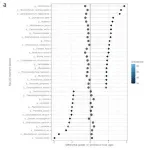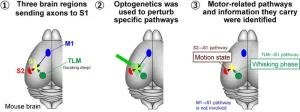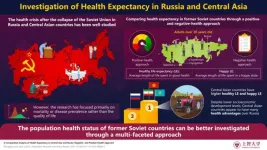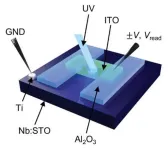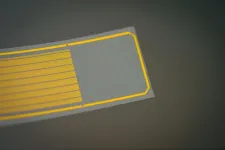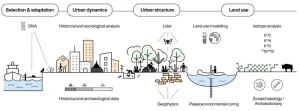(Press-News.org) The effects of aging and external factors like UV exposure on skin are well documented. As people age or spend more time in the sun, their skin tends to become drier and more wrinkled,
Recent findings have identified an exciting potential new link to signs of skin aging—the skin microbiome, the collection of microorganisms that inhabits our skin. The results come from a collaborative study carried out by researchers at the Center for Microbiome Innovation (CMI) at the University of California San Diego (UC San Diego) and L'Oréal Research and Innovation.
Their work was published in Frontiers in Aging on January 11, 2024, in an article entitled “A multi-study analysis enables identification of potential microbial features associated with skin aging signs.” To the best of the team's knowledge, the study is the first to isolate microbes associated specifically with signs of skin aging and skin health, rather than chronological age.
Combining CMI's sophisticated data analysis abilities with L'Oréal's knowledge and expertise in skin health assessment, the study comprehensively examined data collected during 13 studies that L’Oréal had carried out in the past, consisting of 16S rRNA amplicon sequence data and corresponding skin clinical data for over 650 female participants, aged 18 - 70. While each of the studies included in the analysis had focused on one particular area of interest—for example, crow’s feet wrinkles or moisture loss—this multi-study analysis collated the data to search for trends related to specific microbes while accounting for other variables, such as age.
“Previous studies have shown that the types of microbes on our skin change fairly predictably with age,” said corresponding author Se Jin Song, the CMI Director of Research. “Our skin also changes physiologically with age; for example, we gain wrinkles and our skin gets drier. But there is variation in what this looks like in people—you've probably noticed that there are some people who have younger or older looking skin than many others their age. Using advanced statistical methods, we were able to tease apart the microbes that are associated with these types of aging signs for skin, like crow's feet wrinkles, from those that are associated with simply age as a chronological number.”
Two notable trends emerged from the analysis. First, the team found a positive association between skin microbiome diversity and lateral cantonal lines (crow’s feet wrinkles), which are generally viewed as one of the key signs of skin aging. Second, they observed a negative correlation between microbiome diversity and transepidermal water loss, which is the amount of moisture that evaporates through the skin. In further exploring the trends, the researchers identified several potential biomarkers that warrant investigation as microorganisms of interest. It would be premature to infer causation or actionable insights, but the study’s results have provided researchers with directions on the next steps to hone in on better understanding microbial associations with skin aging.
"At L'Oréal, our commitment is to create beauty products that meet the unique needs of each individual. Our recent collaboration with the Center for Microbiome Innovation has shed light on the role of the skin microbiome in aging, particularly in how it affects wrinkles and overall skin quality," said co-author Qian Zheng, Head of Advanced Research, North America at L'Oréal. "This research is groundbreaking in identifying new microbial biomarkers linked to visible signs of aging like crow's feet wrinkles. It marks a significant step towards developing technologies for healthier, more youthful skin. We look forward to sharing new results as they become available, furthering the scientific community's understanding and contributing to advancing new skincare solutions."
Future paths of investigation the team has suggested include metabolomics work to discover chemical biomarkers related to skin aging, as well as meta-transcriptomics research into potential targets for genetic engineering. Research into other layers of the skin has also been considered, as many studies focus on the outer skin due to the ease of sample collection.
"While the study's findings represent an advance of our knowledge of the skin microbiome, we view them as just the beginning of a new phase of research," said co-author Rob Knight, the CMI Faculty Director and Professor of Pediatrics, Bioengineering, Computer Science & Engineering and Data Science at UC San Diego. "By confirming a link between the microbiome and skin health, we've laid the groundwork for further studies that discover specific microbiome biomarkers related to skin aging, and, one day, show how to modify them to generate novel and highly targeted recommendations for skin health."
Additional co-authors include Tyler Myers, Shi Huang, and Shalisa T. Hansen, all at UC San Diego; and Amina Bouslimani, Cecile Clavaud, Anissa Azouaoui, Alban Ott, Audrey Gueniche, Charbel Bouez, Luc Aguilar, and Magali Moreau, all at L'Oréal Research and Innovation.
The Center for Microbiome Innovation at UC San Diego is proud to include Rob Knight and Se Jin Song on its leadership team.
The study was funded through a sponsored research agreement between L'Oréal Research and Innovation and the Center for Microbiome Innovation at UC San Diego.
Disclosure: Amina Bouslimani, Cecile Clavaud, Anissa Azouaoui, Alban Ott, Audrey Gueniche, Charbel Bouez, Qian Zheng, Luc Aguilar, and Magali Moreau are all employees of L'Oréal Research and Innovation. The other authors declare no potential conflict of interest.
END
Researchers discover potential microbiome links to skin aging
New analysis reveals how skin microbiome could be associated with wrinkles and skin health
2024-01-11
ELSE PRESS RELEASES FROM THIS DATE:
Join us in sunny San Diego for the ATS 2024 International Conference May 19-22
2024-01-11
What’s New: Register now to learn about the latest in pulmonary, critical care and sleep medicine. Join us for scientific sessions and expert interviews. Thirteen sessions will be livestreamed.
Why it matters: Stay up-to-date on subjects like COVID-19, asthma, COPD, and air pollution. We’ll assist you with conducting interviews, whether in-person or from your home office.
Contact Kevin Tuerff, ATS Communications & Marketing for more information, at ktuerff@thoracic.org END ...
Chemical Insights Research Institute commits to public health research with the opening of new laboratories
2024-01-11
ATLANTA – Chemical Insights Research Institute (CIRI) of UL Research Institutes confirmed its commitment to protecting environmental and human health when it opened its new research laboratories supporting scientific studies of environmental exposure and its societal health impact. At a ribbon cutting today, CIRI introduced the Center for Exposure Science; the Center for Toxicology and Human Health; and the Center for Advanced Measurements, each with a designated, cutting-edge laboratory.
Using the latest tools for measuring nanosized particles and parts per billion levels of chemicals and developing high-throughput cellular techniques for measuring human toxicity, ...
Challenging the traditional views on how the brain processes movement and sensation
2024-01-11
The brain is widely considered the most complex organ in the human body. The intricate mechanisms through which it processes sensory information and how this information affects and is affected by motor control have captivated neuroscientists for more than a century. Today, thanks to advanced laboratory tools and techniques, researchers can use animal models to solve this puzzle, especially in the mouse brain.
During the 20th century, experiments with anesthetized mice proved that sensory inputs primarily define neuronal activity in the primary ...
Understanding healthy and happy expectancy in former soviet countries
2024-01-11
The dissolution of the Soviet Union in 1991 marked the start of a period ripe with political, economic, and societal changes. In many former Soviet countries, these abrupt and turbulent transformations posed massive challenges to healthcare systems. Together with spikes in job losses and economic hardships, this led to a steep increase in mortality rates that would later come to be known as the “post-Soviet mortality crisis.”
However, this crisis did not affect all former Soviet countries equally. In particular, former Soviet countries in Central Asia, which include Kazakhstan, Kyrgyzstan, Tajikistan, Turkmenistan, and Uzbekistan, saw a ...
Revolutionizing real-time data processing with edge computing and reservoir technology
2024-01-11
Every day, a significant amount of data related to weather, traffic, and social media undergo real-time processing. In traditional cloud computing, this processing occurs on the cloud, raising concerns about issues such as leaks, communication delays, slow speeds, and higher power consumption. Against this backdrop, “edge computing” presents a promising alternative solution. Located near users, it aims to distribute computations, thereby reducing the load and speeding up data processing. Specifically, edge AI, which involves AI processing at the edge, is expected to find applications in, for example, self-driving ...
Generating stable qubits at room temperature
2024-01-11
Fukuoka, Japan—In a study published in Science Advances, a group of researchers led by Associate Professor Nobuhiro Yanai from Kyushu University's Faculty of Engineering, in collaboration with Associate Professor Kiyoshi Miyata from Kyushu University and Professor Yasuhiro Kobori of Kobe University, reports that they have achieved quantum coherence at room temperature: the ability of a quantum system to maintain a well-defined state over time without getting affected by surrounding disturbances
This breakthrough was made possible by embedding a chromophore, ...
Potential solvents identified for building on moon and Mars
2024-01-11
PULLMAN, Wash. -- Researchers have taken the first steps toward finding liquid solvents that may someday help extract critical building materials from lunar and Martian-rock dust, an important piece in making long-term space travel possible.
Using machine learning and computational modeling, Washington State University researchers have found about half a dozen good candidates for solvents that can extract materials on the moon and Mars usable in 3D printing. The work, reported in the Journal of Physical Chemistry B, is led by Soumik Banerjee, associate professor in WSU’s School of Mechanical ...
Generative artificial intelligence models effectively highlight social determinants of health in doctors’ notes
2024-01-11
Where we live and work, our age, and the conditions we grew up in can influence our health and lead to disparities, but these factors can be difficult for clinicians and researchers to capture and address. A new study by investigators from Mass General Brigham demonstrates that large language models (LLMs), a type of generative artificial intelligence (AI), can be trained to automatically extract information on social determinants of health (SDoH) from clinicians’ notes which could augment efforts to identify patients who may benefit from ...
Transparent brain implant can read deep neural activity from the surface
2024-01-11
Researchers at the University of California San Diego have developed a neural implant that provides information about activity deep inside the brain while sitting on its surface. The implant is made up of a thin, transparent and flexible polymer strip that is packed with a dense array of graphene electrodes. The technology, tested in transgenic mice, brings the researchers a step closer to building a minimally invasive brain-computer interface (BCI) that provides high-resolution data about deep neural activity by using recordings from the brain surface.
The work was published on Jan. 11 in Nature Nanotechnology.
“We are expanding the spatial ...
Ancient cities provide key datasets for urban planning, policy and predictions in the Anthropocene
2024-01-11
Cities play a key role in climate change and biodiversity and are one of the most recognizable features of the Anthropocene. They also accelerate innovation and shape social networks, while perpetuating and intensifying inequalities. Today over half of all humanity lives in cities, a threshold which will rise to nearly 70% by the mid-21st century. Yet despite their importance for the Anthropocene, cities are not a recent phenomenon.
In a new study, an interdisciplinary team of authors from the Max Planck Institute of Geoanthropology ...
LAST 30 PRESS RELEASES:
Tracing the quick synthesis of an industrially important catalyst
New software sheds light on cancer’s hidden genetic networks
UT Health San Antonio awarded $3 million in CPRIT grants to bolster cancer research and prevention efforts in South Texas
Third symposium spotlights global challenge of new contaminants in China’s fight against pollution
From straw to soil harmony: International team reveals how biochar supercharges carbon-smart farming
Myeloma: How AI is redrawing the map of cancer care
Manhattan E. Charurat, Ph.D., MHS invested as the Homer and Martha Gudelsky Distinguished Professor in Medicine at the University of Maryland School of Medicine
Insilico Medicine’s Pharma.AI Q4 Winter Launch Recap: Revolutionizing drug discovery with cutting-edge AI innovations, accelerating the path to pharmaceutical superintelligence
Nanoplastics have diet-dependent impacts on digestive system health
Brain neuron death occurs throughout life and increases with age, a natural human protein drug may halt neuron death in Alzheimer’s disease
SPIE and CLP announce the recipients of the 2025 Advanced Photonics Young Innovator Award
Lessons from the Caldor Fire’s Christmas Valley ‘Miracle’
Ant societies rose by trading individual protection for collective power
Research reveals how ancient viral DNA shapes early embryonic development
A molecular gatekeeper that controls protein synthesis
New ‘cloaking device’ concept to shield sensitive tech from magnetic fields
Researchers show impact of mountain building and climate change on alpine biodiversity
Study models the transition from Neanderthals to modern humans in Europe
University of Phoenix College of Doctoral Studies releases white paper on AI-driven skilling to reduce burnout and restore worker autonomy
AIs fail at the game of visual “telephone”
The levers for a sustainable food system
Potential changes in US homelessness by ending federal support for housing first programs
Vulnerability of large language models to prompt injection when providing medical advice
Researchers develop new system for high-energy-density, long-life, multi-electron transfer bromine-based flow batteries
Ending federal support for housing first programs could increase U.S. homelessness by 5% in one year, new JAMA study finds
New research uncovers molecular ‘safety switch’ shielding cancers from immune attack
Bacteria resisting viral infection can still sink carbon to ocean floor
Younger biological age may increase depression risk in older women during COVID-19
Bharat Innovates 2026 National Basecamp Showcases India’s Most Promising Deep-Tech Ventures
Here’s what determines whether your income level rises or falls
[Press-News.org] Researchers discover potential microbiome links to skin agingNew analysis reveals how skin microbiome could be associated with wrinkles and skin health


